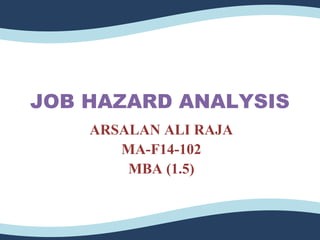
Job hazard analysis
- 1. JOB HAZARD ANALYSIS ARSALAN ALI RAJA MA-F14-102 MBA (1.5)
- 2. Definition Job Hazard Analysis (JHA) is a procedure for identifying hazards associated with each step of a job. It aids in developing solutions to the removal or control of each exposure to a hazard.
- 3. Objective Job Hazard Analysis (JHA) is an important method of identifying hazards and safety concerns prior to their actually resulting in accidents.
- 4. BenefitsA JHA helps management to identify unsafe and inefficient steps in work processes and often leads to improvements in the safety of the total job while improving efficiency. A JHA forces management to make a judgment as to:
- 5. Benefits (Cont.) Better work planning may result from completion of a thorough JHA. Supervisors develop a stronger understanding of the jobs which they supervise. Policies and procedures are often improved after doing a JHA.
- 6. Selecting a Job to Analyze Jobs which are good candidates for a JHA would include job which: Have a high frequency of accidents. Have resulted in a disabling injury. Have the potential for causing serious injury. Are new or have undergone significant changes in procedures or equipments. Are done seasonally or infrequently, but may have a potential for causing severe injury.
- 7. What to do after the JHA Whenever there is an accident involving a job that has had a Job Hazard Analysis done on it, the JHA should be reviewed to determine whether or not it needs to be revised. If an accident occurs as a result of not following procedures developed by the JHA, the facts should be discussed with the workers who do the job. It should be pointed out that following the JHA would have prevented the accident.
- 8. What to do after the JHA (Cont.) The JHA should be used as starting and focal points around which to build a training program. On-the-job training must follow the guidelines spelled out in the JHA. Supervisors should use JHA as subjects for both planned and unplanned safety contacts (talks) with the workers.
- 9. ` What to do after the JHA (Cont.) Workers should be observed in order to identify behavior that is out of line with procedures as listed in the JHA. Non-conforming, unsafe behavior should be corrected. Non-conforming behavior that appears to be an improvement on the JHA work practice should be evaluated and incorporated into a revised JHA.
- 10. Job Hazard Analysis GuideSequence of Basic Job Steps Break the job down into steps -- what is done first, second, third, ... We can do this by: 1. Observing the job. 2. Discussing it with the supervisor and/or the worker performing the job or task. 3. Drawing upon our knowledge of the job. 4. A combination of these approaches. Record the job steps in their normal order. Describe what is done, not the details of how it is done. Three- or four-word descriptions should be enough.
- 11. Job Hazard Analysis Guide (Cont.) Potential Accidents or Hazards For each job step, ask what accidents could happen to the person doing the job step. We can do this by: 1. Observing the job. 2. Talking to the worker. 3. Studying reports of past accidents. 4. Consulting with subject experts. 5. Or a combination of these approaches.
- 12. Job Hazard Analysis Guide (Cont.) Ask the following questions; Can the worker: 1. Be struck by or against anything? 2. Be caught in, on or between anything? 3. Fall? 4. Strain or over-exert? 5. Be exposed to injurious chemicals, radiation, or substances? 6. Be exposed to hazardous energy sources?
- 13. Job Hazard Analysis Guide (Cont.) For each potential hazard or accident cause, ask how the worker could avoid the hazard or how it might be eliminated or reduced. 1. Observe the job for possible changes to be made, 2. Discuss possible precautions or changes with the worker, 3. Draw upon our own knowledge and experience of the task or potential hazards. 4. Any combination of the above. Use "action verbs." Do not use general, non-descript statements. Be concise, yet complete. Recommendations should be numbered the same as the hazards they address.
- 14. Recommended Safe Behavior 1.Never use tools or work with equipment that you are not knowledgeable of or have not been trained to use. 2. Always use proper lockout and tag out procedures to prevent unexpected movement or operation of equipment being repaired, unclogged, or setup. 3. Shut off equipment before adjusting, cleaning, repairing, or oiling it. Use Lockout and Tag out procedures for potentially hazardous activities. 4. Always follow warning signs, labels, tags, signals, etc. Speak up if you see someone working in a potentially unsafe manner -- look out for each other. 5.Do not walk, run, or drive equipment too fast for the surrounding conditions, work force present, weather conditions, etc.
- 15. Recommended Safe Behavior (Cont.)6. Pass materials or tools to each other, do not throw or toss them. This is important especially for heavy, sharp or awkwardly shaped objects. 7. Avoid jumping from elevations such as ladders, platforms, steps, truck beds, etc. or between surface levels. Use stairs, steps, ladders, etc. to safely lower yourself. 8. NEVER remove, inactivate, or in anyway tamper with safety guards, interlocks, or other safety devices. They are there to protect you. 9. Report damaged or defective safety devices immediately for repair. 10. Never knowingly use damaged or defective equipment. Report or turn in such equipment for repair or replacement
- 16. Thank you Questions & Answers